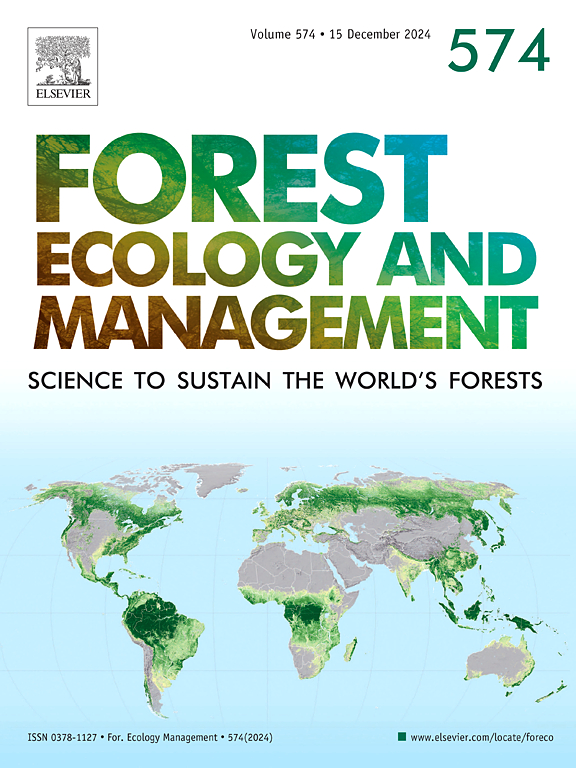IF 3.7
2区 农林科学
Q1 FORESTRY
引用次数: 0
摘要
森林用火制度的变化,包括规定用火的增加,很可能会影响动物的健康。我们研究了在澳大利亚南部生物多样性热点地区的原生森林中,预设火灾对爬行动物身体状况、受伤频率和重新捕获频率的影响。我们共进行了 6375 个诱捕日,处理了 8 个物种的 1750 只个体。我们发现,最常见的物种 Lampropholis guichenoti 的身体状况在火灾刚发生后最低,而在火灾发生超过 20 年的地点则最高。身体状况在六个月后有所改善,并在不同季节有所变化。尾部受伤的频率与火灾发生后的时间无关,但在两个物种中,受伤个体的身体状况较差。在未被烧毁的地点,L. guichenoti 的重捕频率最高,这表明在 20 年内被烧毁的地点死亡率较高或迁出率较高。我们的研究表明,火灾发生后,该物种的身体状况会立即变差,对地点的忠诚度和存活率也会随之降低。两个物种的身体状况没有变化,而L. guichenoti在火灾后和不同季节的身体状况恢复较快,这可能反映了物种特有的行为、食物供应和/或捕食者暴露。未来的研究应侧重于火灾后生存、运动和个体健康特征之间的相互作用,以全面评估火灾的持续后果,尤其是对那些经常被烧毁或受到威胁的生态系统或那些在十年时间尺度内会发生演替变化的生态系统中的物种。本文章由计算机程序翻译,如有差异,请以英文原文为准。
Effects of prescribed fire on body condition, injury frequency, and recapture of reptiles in Mediterranean-type eucalypt forests
Changing fire regimes in forests, including increases in prescribed burning, are likely to affect animal health. We studied the effects of prescribed fire on body condition, injury frequency, and recapture frequency of reptiles in native forests of a southern Australian biodiversity hotspot. We conducted 6375 trap days and processed 1750 individuals of eight species. Three species accounted for 96 % of captures, and we found that body condition for Lampropholis guichenoti, the most common species, was lowest immediately after burning and highest in sites exceeding 20 years since fire. Body condition improved after six months and varied across seasons. Frequency of caudal injuries and time since fire were not related, but condition was poorer in injured individuals in two species. Recapture frequency of L. guichenoti was highest in unburnt sites, suggesting higher mortality or emigration in sites burnt within 20 years. Our study demonstrated that body condition and, potentially, site fidelity and survival in this species are poorer immediately after fire. The unchanged condition of two species and the rapid recovery of body condition of L. guichenoti after fire and across seasons may reflect species-specific behaviour, food availability, and/or predator exposure. Future studies should focus on post-fire interactions among survival, movement, and individual health characteristics to evaluate fully the ongoing consequences of fire, particularly for species occupying frequently burnt or threatened ecosystems or those subject to successional change over decadal timescales.
求助全文
通过发布文献求助,成功后即可免费获取论文全文。
去求助
来源期刊

Forest Ecology and Management
农林科学-林学
CiteScore
7.50
自引率
10.80%
发文量
665
审稿时长
39 days
期刊介绍:
Forest Ecology and Management publishes scientific articles linking forest ecology with forest management, focusing on the application of biological, ecological and social knowledge to the management and conservation of plantations and natural forests. The scope of the journal includes all forest ecosystems of the world.
A peer-review process ensures the quality and international interest of the manuscripts accepted for publication. The journal encourages communication between scientists in disparate fields who share a common interest in ecology and forest management, bridging the gap between research workers and forest managers.
We encourage submission of papers that will have the strongest interest and value to the Journal''s international readership. Some key features of papers with strong interest include:
1. Clear connections between the ecology and management of forests;
2. Novel ideas or approaches to important challenges in forest ecology and management;
3. Studies that address a population of interest beyond the scale of single research sites, Three key points in the design of forest experiments, Forest Ecology and Management 255 (2008) 2022-2023);
4. Review Articles on timely, important topics. Authors are welcome to contact one of the editors to discuss the suitability of a potential review manuscript.
The Journal encourages proposals for special issues examining important areas of forest ecology and management. Potential guest editors should contact any of the Editors to begin discussions about topics, potential papers, and other details.
 求助内容:
求助内容: 应助结果提醒方式:
应助结果提醒方式:


